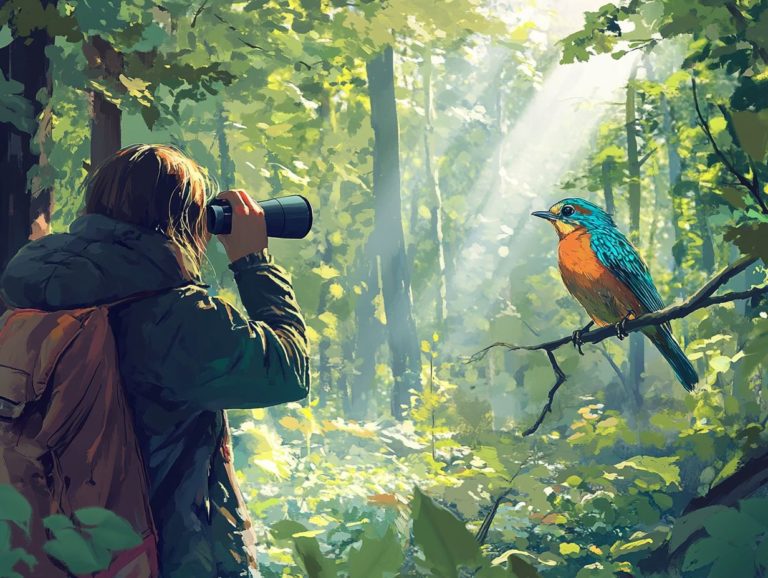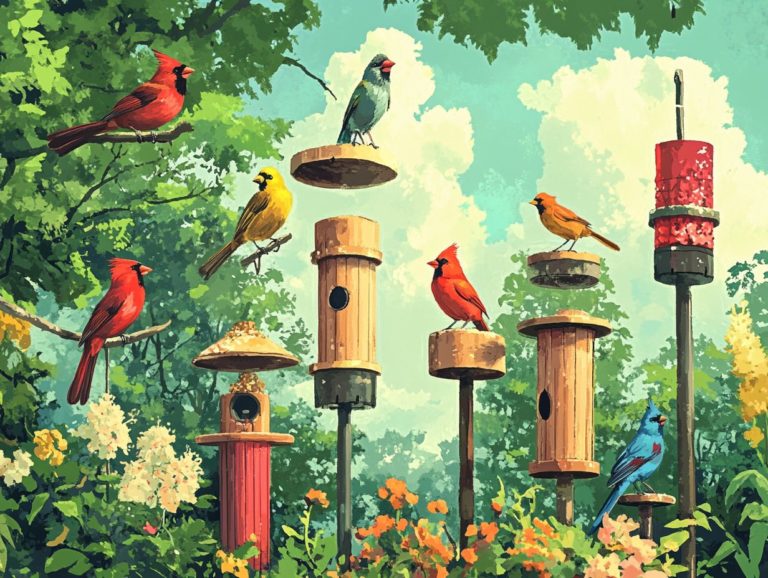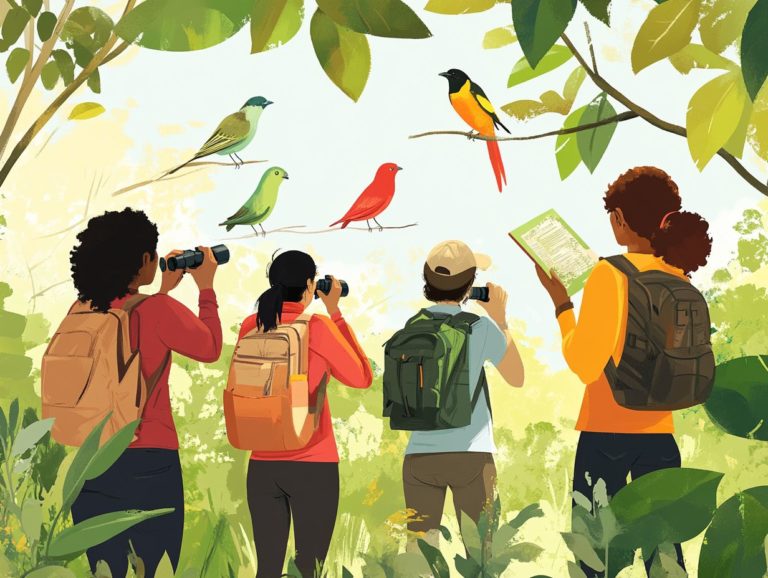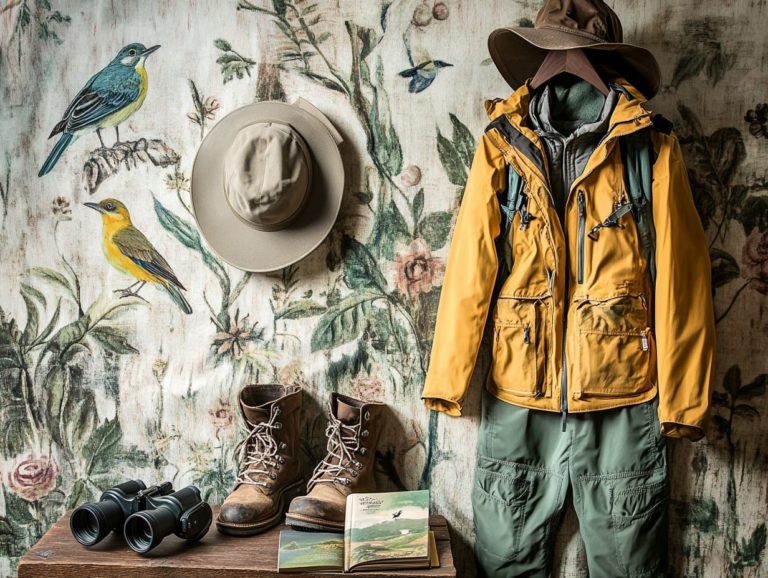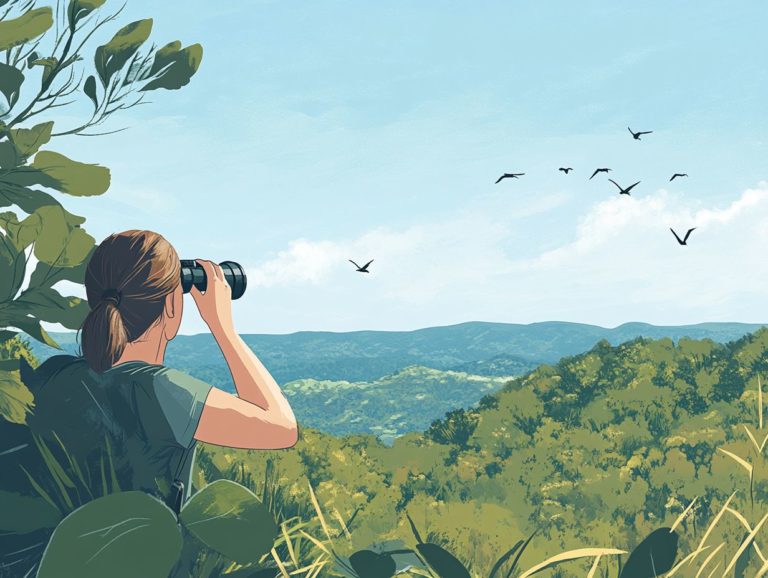How to Host a Bird Watching Event?
Bird watching transcends being merely a leisurely pastime; it s a remarkable opportunity to connect with nature and savor the beauty of avian life, celebrating the contributions of Black excellence in the field.
If you re contemplating hosting a birding event, get ready for an enriching experience that will unite enthusiasts of all ages.
Our guide will help you plan an unforgettable bird watching event, covering everything from choosing the ideal location to engaging activities and ensuring the safety of all participants, like those celebrated during Black Birders Week.
Whether you’re a seasoned birdwatcher or a curious novice, you ll find something here to delight and inspire you, including insights from notable figures such as Christian Cooper.
Contents
- Key Takeaways:
- Planning a Bird Watching Event
- Activities for the Event
- Ensuring Safety and Comfort
- Wrapping up the Event
- Frequently Asked Questions
- What is bird watching and why should I host an event?
- What are the steps to host a successful bird watching event?
- Do I need to have experience in bird watching to host an event?
- What are some fun activities to include in a bird watching event?
- Is there an ideal time of day to host a bird watching event?
- How can I ensure the safety of participants during a bird watching event?
Key Takeaways:

- Choose a suitable location that offers a variety of bird species and comfortable viewing conditions.
- Include interactive activities like guided bird walks, identification games, and photography contests to engage participants and promote learning.
- Prioritize safety and comfort by considering weather conditions, having first aid plans in place, and collecting feedback from participants for future events.
What is Bird Watching?
Bird watching, or birding, is much more than just a pastime; it s an enriching experience that connects you with nature while allowing you to appreciate the beauty of biodiversity the variety of life in our world. This delightful hobby has gained momentum across many communities, including Black birders who engage in initiatives like Black Birders Week and participate in organized events and local birding groups that promote outreach and inclusivity.
In recent years, bird watching has become increasingly popular, drawing individuals from all walks of life eager to learn about the myriad avian species that grace our planet. Your techniques in birding can vary widely, from simply observing with the naked eye to using advanced binoculars and field guides to help identify and understand different species.
Pay special attention to migratory birds; tracking their seasonal patterns offers remarkable insights into ecological changes. Birding groups are vital in fostering outreach, creating a sense of community, and encouraging diverse membership across various demographics. These groups not only educate communities about avian habitats but also inspire the next generation of bird lovers.
Benefits of Hosting a Bird Watching Event
Hosting a birdwatching event offers a wealth of benefits. It fosters genuine connections among participants and promotes storytelling that celebrates local biodiversity and conservation initiatives. For those interested in organizing such an event, learning how to host a field guide birdwatching group can be invaluable.
These gatherings serve as platforms for discussing broader issues such as environmentalism, racial justice, and the significance of inclusivity for all nature enthusiasts, particularly those from marginalized backgrounds.
Uniting people from different backgrounds creates an environment where meaningful conversations can flourish. This raises awareness about urgent environmental concerns and their critical ties to social justice.
Participants often bring their unique perspectives, enriching the experience and deepening everyone’s appreciation for both nature and community.
Such events empower local advocacy efforts, inspiring attendees to become stewards of their environment while building a network that champions equitable access to natural spaces.
Ultimately, by promoting inclusivity and understanding, birdwatching events can foster a sense of belonging that extends far beyond the activity itself.
Planning a Bird Watching Event
Planning a bird-watching event requires careful organization to guarantee a rewarding experience for all participants. Additionally, understanding how to teach kids about bird watching is essential to engage younger attendees, ensuring accessibility challenges are addressed and effective outreach initiatives are implemented.
By prioritizing the creation of inclusive spaces through engaging discussions and providing accessible resources, you can cultivate a welcoming environment that encourages diverse membership and enriches the overall experience for everyone involved.
Choosing a Location
Selecting the perfect location for your bird watching event is essential. Ideally, you want a public preserve or a site celebrated for its rich biodiversity, defined as the variety of life in a particular area, and a variety of bird species, especially those enchanting migratory songbirds. Connecting with local birding groups can offer you invaluable insights into the best spots for sightings.
Beyond biodiversity, accessibility is crucial for allowing bird watchers of all skill levels to truly savor the experience. Consider how easily participants can reach the site, whether they can navigate the terrain comfortably, and if there are convenient amenities like restrooms and parking.
Local birding groups often emphasize the significance of choosing areas that not only support diverse habitats for migratory birds but also feature well-maintained trails and observation points. This combination enhances enjoyment and fosters engagement with ecosystems, allowing you and your participants to appreciate the beauty and complexity of avian life.
Inviting Participants
Inviting participants to your birdwatching event demands a thoughtful approach to community outreach that targets a diverse audience. To enhance the experience, consider making bird watching a family activity to ensure nature lovers from all backgrounds feel welcome, particularly through youth programs that inspire the next generation to immerse themselves in birdwatching, cultivating a sense of belonging and appreciation for avian life.
To effectively attract families and young individuals, consider leveraging social media platforms, local schools, and community centers to spread the word about your event. Partnering with local organizations focused on environmental education can enhance your outreach efforts, connecting with those who may not have previously engaged in such activities.
Offering interactive workshops or informational sessions not only sparks interest but also showcases the joy and serenity that birdwatching can offer to people of all ages. Providing materials in multiple languages enhances accessibility, inviting a broader audience to join in the exploration of this rewarding outdoor pursuit.
Preparing Supplies and Equipment
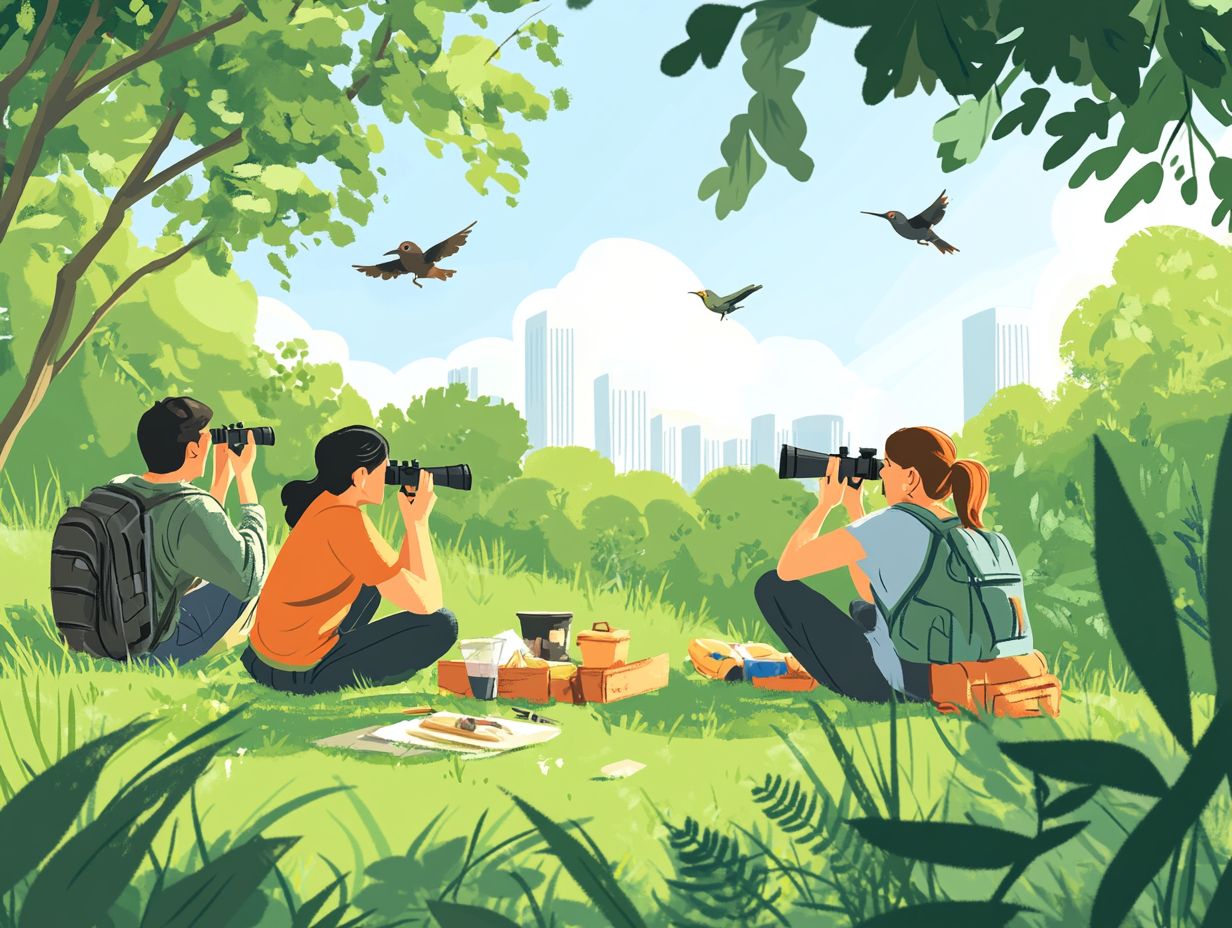
Gathering the right supplies is key to a successful bird-watching event. Ensure you and your participants have access to resources such as binoculars, field guides, which are books that help identify different bird species, and safety materials. By considering accessibility challenges and providing adequate resources, you can significantly enhance the overall birding experience for everyone.
This preparation extends far beyond simply supplying gear; it involves understanding the diverse needs of all participants. For instance, sturdy notebooks for jotting down observations, durable backpacks for carrying essentials, and portable chairs can make the experience more enjoyable and comfortable for everyone involved.
It’s crucial to prioritize safety by equipping each participant with first-aid kits and clear guidelines for navigating natural environments. Ensuring that all tools and equipment are user-friendly and accessible will foster an inclusive atmosphere, encouraging individuals of all backgrounds and abilities to connect with nature and enjoy the captivating world of birds.
Activities for the Event
Incorporating a diverse array of activities into your bird-watching event can boost participant engagement, transforming the experience into something truly memorable and enjoyable.
Consider including engaging discussions that tie into scientific research and the importance of storytelling in connecting with nature.
- Join guided bird walks led by knowledgeable experts,
- Participate in interactive bird identification games that spark curiosity, and
- Enter thrilling photography contests that inspire attendees to capture the beauty of migratory birds and local wildlife.
Each element adds depth and excitement, ensuring that everyone leaves with lasting memories. Don t miss out on the chance to connect with nature!
Guided Bird Walks
Guided bird walks are a fantastic way to elevate your birding experience. Expert birders share insights and engage you with stories about local ecosystems and bird species.
These walks are educational and foster meaningful connections among participants, contributing to a sense of community.
By integrating informative discussions about birds’ habits, habitats, and migration patterns, these outings allow you to appreciate nature on a deeper level. Organizing effective guided walks involves creating inclusive spaces for all skill levels.
- Select accessible locations rich in biodiversity.
- Train knowledgeable leaders.
- Promote the event to attract a diverse audience.
You ll be thrilled by the contagious enthusiasm of expert birders, whose captivating tales bring life to the birds and their environments, echoing the efforts of groups like Philly Queer Birders and Feminist Bird Club.
This enriching setting encourages you to forge friendships and share experiences, fostering a vibrant community of fellow bird enthusiasts.
Bird Identification Games
Bird identification games are fun and interactive. They invite you to recognize various bird species, making learning an engaging experience.
These games accommodate different skill levels, so whether you re a novice or an experienced birdwatcher, you can enhance your knowledge while having a great time.
By incorporating visual aids, such as captivating pictures and audio clips of bird calls, organizers create a multi-sensory experience that appeals to both auditory and visual learners.
Adjustments can be made for various age groups, providing simplified tasks for younger participants and more complex challenges for adults. This fosters a sense of community around a shared passion for ornithology.
These games sharpen your observation skills, cultivate critical thinking, and inspire a deeper awareness of conservation. Each game becomes not just a source of entertainment but also a valuable tool for wildlife education.
Photography Contests
Photography contests can bring an exhilarating twist to your birdwatching event. They motivate you and other participants to capture breathtaking images of migratory birds and local wildlife while showcasing your creativity.
To kick off a successful contest, define clear categories such as best action shot, most artistic capture, or best representation of avian habitats. These diverse options cater to different skill levels and inspire you to explore avian life.
When establishing judging criteria, consider elements like composition, lighting, and originality. Involve a panel of experts in both ornithology and photography to appreciate the artistic merit while honoring the natural behaviors and environments of the subjects.
Ultimately, emphasizing these categories raises awareness of conservation efforts. This transforms the event from merely a contest into a meaningful platform for education and appreciation of bird life.
Ensuring Safety and Comfort
Ensuring your safety and comfort during a birdwatching event is essential. It requires meticulous planning that accounts for weather conditions and any challenges you might encounter.
By equipping yourself with well-defined first aid supplies and a solid emergency plan, you can enjoy peace of mind. This preparation allows you to fully immerse yourself in the birding experience, making it memorable and enjoyable.
Join us for these exciting events and discover the wonderful world of birds!
Weather Considerations
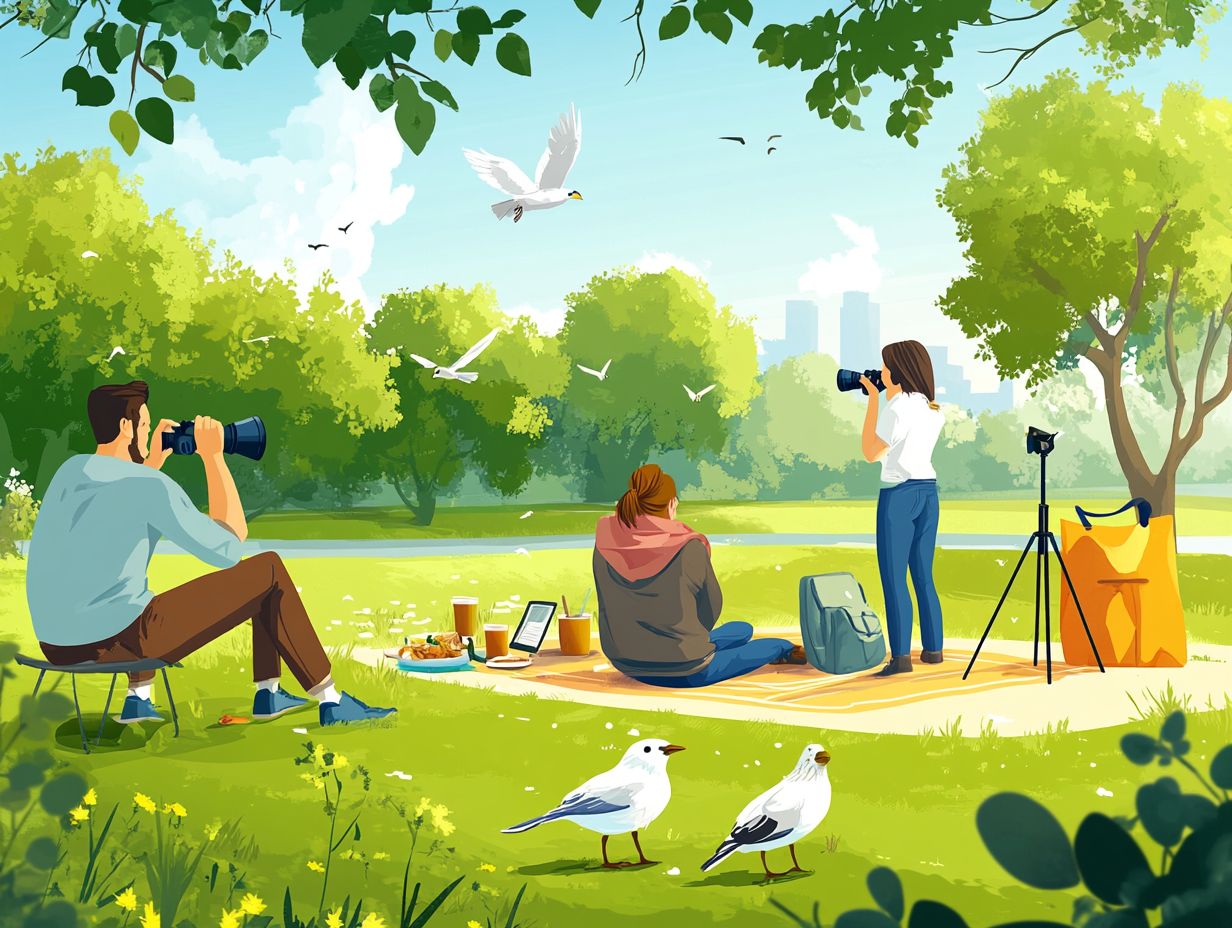
When planning a bird-watching event, considering the weather is key to ensuring participants’ comfort and safety. Unpredictable weather can impact the overall experience, so having backup plans helps tackle any challenges. This way, you can ensure a successful outdoor gathering.
It’s important to assess seasonal patterns, temperature ranges, and precipitation forecasts to guide your decisions. For instance, planning for shade or shelter is vital on sweltering summer days or if unexpected rain showers crash the party.
Providing participants with timely weather updates enhances their preparedness. This allows them to dress appropriately and enjoy the experience fully. Sending communications via email or text keeps everyone informed and fosters a sense of community and engagement.
First Aid and Emergency Plans
Establishing first aid measures and emergency plans for your bird-watching event is key to ensuring everyone’s safety. Being prepared with trained personnel and adequate supplies allows participants to focus on enjoying birdwatching without worry.
Ensure participants have easy access to information about the nearest medical facilities and emergency contacts. Have a solid plan for common outdoor injuries like bites, falls, and allergic reactions.
Designating a first aid station stocked with essential medical supplies ensures swift treatment when needed. Safety measures should include briefings on emergency protocols and encouraging everyone to be aware of their surroundings.
A proactive approach to safety enhances the overall experience and fosters a sense of shared responsibility among participants.
Wrapping up the Event
Wrapping up the bird-watching event is a crucial step that allows you, as the organizer, to reflect on the experience while expressing gratitude to participants and volunteers for their invaluable contributions.
Gathering data and feedback from attendees enriches your understanding and offers valuable insights that can enhance future events. This ensures ongoing improvement and fosters a deeper connection within the community.
Thanking Participants and Volunteers
Thanking participants and volunteers is essential when wrapping up a bird-watching event. It shows appreciation for their time and efforts while nurturing a sense of community. This acknowledgment can forge lasting connections and inspire future participation in birding initiatives.
Expressing gratitude can take various forms, such as personalized thank-you notes, shout-outs on social media, or delightful tokens of appreciation like bird-themed souvenirs. By recognizing each individual’s contributions, you reinforce the importance of collective effort in conservation and the enjoyment of nature.
Engaging the community through appreciation honors their involvement and cultivates a culture of volunteerism and commitment to future events. Creating an atmosphere of thankfulness enriches experiences for everyone, deepening the bond between participants and organizers alike.
Collecting Data and Feedback
Collecting data and feedback after the bird-watching event is crucial. It helps you assess the event’s success and identify areas for improvement.
This process creates a feedback loop that enhances community outreach and strengthens connections.
Use different methods like surveys, informal interviews, and observation to gather insights from attendees. Targeted questionnaires about participant satisfaction and educational value will provide a clear understanding of the experience.
Analyzing the data will help you spot strengths and weaknesses. Sharing these findings fosters engagement and builds excitement for future bird-watching adventures.
Frequently Asked Questions
What is bird watching and why should I host an event?
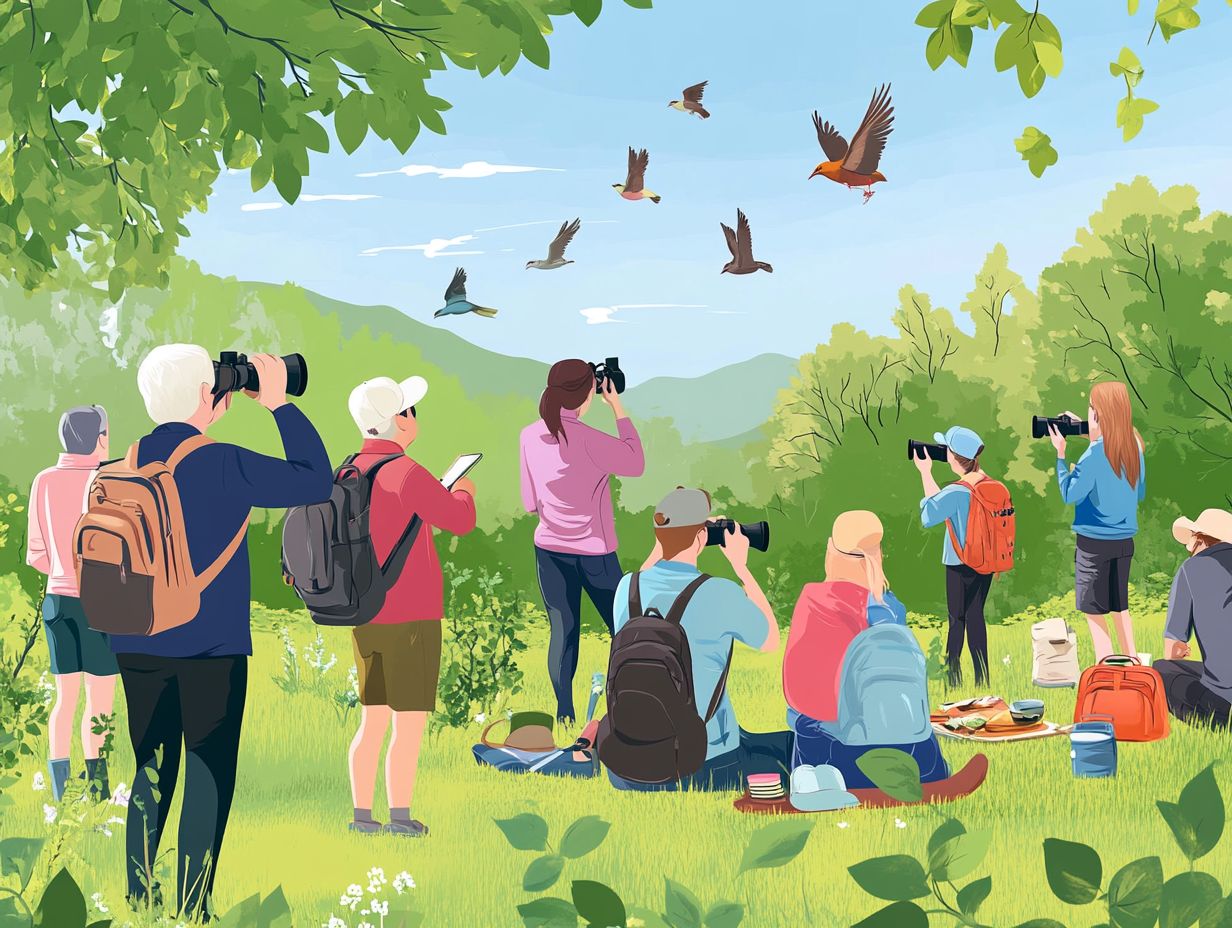
Bird watching involves observing birds in their natural habitats. If you’re interested in this rewarding pastime, learning how to start bird watching as a hobby can enhance your experience. Hosting an event helps you connect with nature and learn about various bird species.
What are the steps to host a successful bird watching event?
Start by choosing a date and location with diverse bird species. For more information, check out local birdwatching events and resources to help promote the event through social media and flyers.
Ensure you have essential equipment like binoculars and guides. Be ready to lead the group and provide information about the birds you spot.
Do I need to have experience in bird watching to host an event?
You don’t need to be an expert to host a bird-watching event. If you’re considering enhancing your experience, check out this guide on how to plan a bird watching trip abroad and invite a local bird expert to assist you.
What are some fun activities to include in a bird watching event?
Engage participants with activities like a scavenger hunt, a bird call competition, or a bird-themed craft session. These add fun and interaction to the event.
Is there an ideal time of day to host a bird watching event?
The best times to observe various bird species are early morning or late afternoon. This is when birds are most active.
You can also plan a full-day event to see different birds at various times.
How can I ensure the safety of participants during a bird watching event?
Set participants in a safe location and provide clear safety instructions. These should include staying on paths and not disturbing the birds.
It s wise to have a first-aid kit available, especially during events like Black Birders Week that celebrate excellence in birdwatching.

